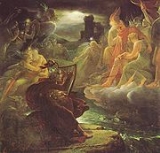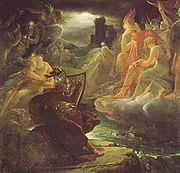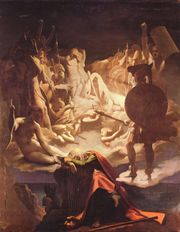
Oisín
Encyclopedia


Ireland
Ireland is an island to the northwest of continental Europe. It is the third-largest island in Europe and the twentieth-largest island on Earth...
, and is a warrior of the fianna
Fianna
Fianna were small, semi-independent warrior bands in Irish mythology and Scottish mythology, most notably in the stories of the Fenian Cycle, where they are led by Fionn mac Cumhaill....
in the Ossianic or Fenian Cycle
Fenian Cycle
The Fenian Cycle , also referred to as the Ossianic Cycle after its narrator Oisín, is a body of prose and verse centering on the exploits of the mythical hero Fionn mac Cumhaill and his warriors the Fianna. It is one of the four major cycles of Irish mythology along with the Mythological Cycle,...
of Irish mythology
Irish mythology
The mythology of pre-Christian Ireland did not entirely survive the conversion to Christianity, but much of it was preserved, shorn of its religious meanings, in medieval Irish literature, which represents the most extensive and best preserved of all the branch and the Historical Cycle. There are...
. He is the son of Fionn mac Cumhaill
Fionn mac Cumhaill
Fionn mac Cumhaill , known in English as Finn McCool, was a mythical hunter-warrior of Irish mythology, occurring also in the mythologies of Scotland and the Isle of Man...
and of Sadhbh (daughter of Bodb Dearg), and is the narrator
Narrator
A narrator is, within any story , the fictional or non-fictional, personal or impersonal entity who tells the story to the audience. When the narrator is also a character within the story, he or she is sometimes known as the viewpoint character. The narrator is one of three entities responsible for...
of much of the cycle.
Legends
His name literally means "young deer" or fawn, and the story is told that his mother, Sadbh, was turned into a deer by a druidDruid
A druid was a member of the priestly class in Britain, Ireland, and Gaul, and possibly other parts of Celtic western Europe, during the Iron Age....
, Fear Doirche (or Fer Doirich). When Fionn was hunting he caught her but did not kill her, and she returned to human form. Fionn gave up hunting and fighting to settle down with Sadbh, and she was soon pregnant, but Fer Doirich turned her back into a deer and she returned to the wild. Seven years later Fionn found her child, naked, on Benbulbin. Other stories have Oisín meet Fionn for the first time as an adult and contend over a roasting pig before they recognise each other.
In Oisín in Tir na nÓg, his most famous echtra
Echtra
An Echtra or Echtrae is one of a category of Old Irish literature about a hero's adventures in the Otherworld ; the otherworldly setting is the distinctive trait of these tales...
or adventure tale, he is visited by a fairy
Fairy
A fairy is a type of mythical being or legendary creature, a form of spirit, often described as metaphysical, supernatural or preternatural.Fairies resemble various beings of other mythologies, though even folklore that uses the term...
woman called Níamh Chinn Óir (Niamh of the Golden Hair or Head, one of the daughters of Manannán Mac Lir, a god of the sea) who announces she loves him and takes him away to Tir na nÓg
Tír na nÓg
Tír na nÓg is the most popular of the Otherworlds in Irish mythology. It is perhaps best known from the story of Oisín, one of the few mortals who lived there, who was said to have been brought there by Niamh of the Golden Hair. It was where the Tuatha Dé Danann settled when they left Ireland's...
("the land of the young", also referred to as Tir Tairngire, "the land of promise"). Their union produces Oisín's famous son, Oscar
Oscar (Irish mythology)
Oscar is a figure in the Fenian Cycle of Irish mythology. He is the warrior son of Oisín and the fairy woman Niamh, who also bore his sister, Plor na mBan. Oisín, in turn, was the son of the epic hero Fionn mac Cumhail...
, and a daughter, Plor na mBan
Plor na mBan
In Irish mythology, Plor na mBan —meaning "the flower of women"—was the beautiful daughter of Oisín and Niamh....
("Flower of Women"). After what seems to him to be three years Oisín decides to return to Ireland, but 300 years have passed there. Niamh gives him her white horse, Embarr, and warns him not to dismount, because if his feet touch the ground those 300 years will catch up with him and he will become old and withered. Oisín returns home and finds the hill of Almu, Fionn's home, abandoned and in disrepair. Later, while trying to help some men who were building a road in Gleann na Smól lift a stone out of the way onto a wagon, his girth breaks and he falls to the ground, becoming an old man just as Niamh had forewarned. The horse returns to Tir na nÓg. In some versions of the story, just before he dies Oisín is visited by Saint Patrick
Saint Patrick
Saint Patrick was a Romano-Briton and Christian missionary, who is the most generally recognized patron saint of Ireland or the Apostle of Ireland, although Brigid of Kildare and Colmcille are also formally patron saints....
. Oisín tells the saint about what happened and dies.
In the tale Acallam na Senórach
Acallam na Senórach
Acallam na Senórach is an important prosimetric Middle Irish narrative dating to the last quarter of the 12th century...
(Tales of the Elders), Oisín and his comrade Caílte mac Rónáin
Caílte mac Rónáin
Caílte mac Rónáin was a nephew of Fionn mac Cumhail and a member of the fianna in the Fenian Cycle of Irish mythology. He could run at remarkable speed and communicate with animals, and was a great storyteller...
survived to the time of Saint Patrick and told the saint the stories of the fianna. This is the source of William Butler Yeats
William Butler Yeats
William Butler Yeats was an Irish poet and playwright, and one of the foremost figures of 20th century literature. A pillar of both the Irish and British literary establishments, in his later years he served as an Irish Senator for two terms...
's poem The Wanderings of Oisin
The Wanderings of Oisin
The Wanderings of Oisin is an epic poem published by William Butler Yeats in 1889 in the book The Wanderings of Oisin and Other Poems. It was his first publication outside of magazines, and immediately won him a reputation as a significant poet....
.
The location of the grave site of Oisín is disputed. It is rumoured to be in Glenalmond
Glenalmond
Glenalmond or Glen Almond is a glen which stretches for several miles to the west of the city of Perth in Perth and Kinross, Scotland and down which the River Almond flows. The upper half of the glen runs through mountainous country and is virtually uninhabited whilst the lower, easterly section...
in Perth, Scotland. Wordsworth wrote a poem on the subject entitled "Glen-Almain, the Narrow Glen". Others say it is located in the Nine Glens of Antrim at a site that has been known for generations as "Oisín's Grave". The megalith
Megalith
A megalith is a large stone that has been used to construct a structure or monument, either alone or together with other stones. Megalithic describes structures made of such large stones, utilizing an interlocking system without the use of mortar or cement.The word 'megalith' comes from the Ancient...
ic court cairn
Court cairn
The court cairn or court tomb is a megalithic type of chamber tomb and gallery grave, specifically a variant of the chambered cairn, found in western and northern Ireland, and in mostly southwest Scotland...
is located on a hillside in Lubitavish, near the Glenann River, outside the village of Cushendall
Cushendall
Cushendall and formerly known as Newtown Glens is a village and townland in County Antrim, Northern Ireland.It is on the A2 coast road between Glenariff and Cushendun, in the Antrim Coast and Glens Area of Outstanding Natural Beauty...
on the North Antrim Coast, and is believed to be the ancient burial place of Oísín.
Macpherson's Ossian
OssianOssian
Ossian is the narrator and supposed author of a cycle of poems which the Scottish poet James Macpherson claimed to have translated from ancient sources in the Scots Gaelic. He is based on Oisín, son of Finn or Fionn mac Cumhaill, anglicised to Finn McCool, a character from Irish mythology...
, the narrator and purported author of a series of poems published by James Macpherson
James Macpherson
James Macpherson was a Scottish writer, poet, literary collector and politician, known as the "translator" of the Ossian cycle of poems.-Early life:...
in the 1760s, is based on Oisín. Macpherson claimed to have translated his poems from ancient sources in the Scottish Gaelic language
Scottish Gaelic language
Scottish Gaelic is a Celtic language native to Scotland. A member of the Goidelic branch of the Celtic languages, Scottish Gaelic, like Modern Irish and Manx, developed out of Middle Irish, and thus descends ultimately from Primitive Irish....
. These poems had widespread influence on many writers including Goethe
Johann Wolfgang von Goethe
Johann Wolfgang von Goethe was a German writer, pictorial artist, biologist, theoretical physicist, and polymath. He is considered the supreme genius of modern German literature. His works span the fields of poetry, drama, prose, philosophy, and science. His Faust has been called the greatest long...
and the young Walter Scott
Walter Scott
Sir Walter Scott, 1st Baronet was a Scottish historical novelist, playwright, and poet, popular throughout much of the world during his time....
, although their authenticity was widely disputed. Modern scholars have demonstrated that Macpherson based his poems on authentic Gaelic ballads, but had adapted them to contemporary sensibilities by altering the original characters and ideas and introduced a great deal of his own.
Other literary and film references
- Oisín is a minor character in The Pursuit of Diarmuid and GráinneThe Pursuit of Diarmuid and GráinneThe Pursuit of Diarmuid and Gráinne is an Irish prose narrative surviving in many variants...
from the Fenian cycleFenian CycleThe Fenian Cycle , also referred to as the Ossianic Cycle after its narrator Oisín, is a body of prose and verse centering on the exploits of the mythical hero Fionn mac Cumhaill and his warriors the Fianna. It is one of the four major cycles of Irish mythology along with the Mythological Cycle,...
of stories. - The poem "Ogum i llia lia uas lecht" in the Book of LeinsterBook of LeinsterThe Book of Leinster , is a medieval Irish manuscript compiled ca. 1160 and now kept in Trinity College, Dublin, under the shelfmark MS H 2.18...
is ascribed to Oisín. - Oisín, along with St. Patrick, is the main character of William Butler Yeats's epic poem The Wanderings of OisinThe Wanderings of OisinThe Wanderings of Oisin is an epic poem published by William Butler Yeats in 1889 in the book The Wanderings of Oisin and Other Poems. It was his first publication outside of magazines, and immediately won him a reputation as a significant poet....
. - Tír na nÓg is the name given to a large white horse in the Mike NewellMike Newell (director)Michael Cormac "Mike" Newell is an English director and producer of motion pictures for the screen and for television. After the release of Harry Potter and the Goblet of Fire in 2005, Newell became the third most commercially successful British director in recent years, behind Christopher Nolan...
film Into the WestInto the West (film)Into the West is a 1992 Irish fantasy film about Irish Travellers, directed by Mike Newell and written by Jim Sheridan.The film has received several awards for Best Film, Best European Film, and Outstanding Family Foreign Film.-Synopsis:...
. In the story, Grandfather Reilly is followed to Dublin by this white horse, and gives it to his grandsons, Ossie (Oisín) and Tayto. Grandfather tells them the horse is called "Tír na nÓg" and relates a version of the story of Oisín going to Tír na nÓg, the mythical OtherworldOtherworldOtherworld, or the Celtic Otherworld, is a concept in Celtic mythology that refers to the home of the deities or spirits, or a realm of the dead.Otherworld may also refer to:In film and television:...
. As the family are travellersIrish TravellerIrish Travellers are a traditionally nomadic people of ethnic Irish origin, who maintain a separate language and set of traditions. They live predominantly in the Republic of Ireland, the United Kingdom and the United States.-Etymology:...
, Oisín is referred to in the grandfather's account as "the most handsome traveller who ever lived" rather than as the fenian character of legend. The horse is later confiscated by the police, but the boys steal it back, resulting in a chase across Ireland to the west coast. - In The Fifth Generation, a novel written by Dale Jay Dennis, the lead male character relates the story of Oisín's travels to and return from Tir na nÓg as an allegory to human failings.
- In Shadowmagic, a novel and podiobook by John LenahanJohn LenahanFor the pianist, see John LenehanJohn Lenahan is an American illusionist and entertainer resident in the UK since 1984...
, Oisín is the king of Tír na nÓg and the father of Connor, the lead character.
Use in genetics
- In Blood of the Isles, Bryan SykesBryan SykesBryan Sykes is a former Professor of Human Genetics at the University of Oxford and a current Fellow of Wolfson College.Sykes published the first report on retrieving DNA from ancient bone...
gives the populations associated with Y-DNA Haplogroup R1bHaplogroup R1b (Y-DNA)The point of origin of R1b is thought to lie in Eurasia, most likely in Western Asia. T. Karafet et al. estimated the age of R1, the parent of R1b, as 18,500 years before present....
the name "Oisín" for a clan patriarch, much as he did for mitochondrial haplogroups in his work The Seven Daughters of EveThe Seven Daughters of EveThe Seven Daughters of Eve is a book by Bryan Sykes that presents the theory of human mitochondrial genetics to a general audience...
.

